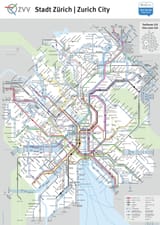Search Results
5/27/2025, 11:53:11 AM
>>2040819
I'm a staunch defender of the Zurich model: Suburban trains (with local and express services) + trams and buses.
I think for most small and medium cities this works best, and you only really need proper subways for very large cities like 3 million pop. (5 million metro pop.) upwards.
Usually you'll have a relatively compact urban core which is best covered by trams, since subways are inefficient due to the time lost getting to and from the station. See Barcelona as negative example, where trips are often just 6-7 stations by subway which point to point is barely faster than a well-prioritized tram would be. And combining suburban train with subway is similarly impractical, since you already get dropped off fairly close and will have to do a short and inefficient subway journey, often with a just as inefficient changeover.
Also when subways are built then less suburban train lines are built in the urban area (tendency towards just the trunk lines), hence making it less comfortable for people from the periphery to reach the city, instead having to rely on subways for long trips which again is less efficient than suburban trains which may even offer express services.
The train+tram approach also gives centrality to train stations, since they aren't so frequent as subway stations would be. This leads to urban development having varied density, denser near the stations and less dense further from them. Good example for this is Tokyo albeit on a bigger scale ofc so subways do make sense there.
Having areas of centrality and areas of lower density makes the combination of trains+trams very convenient, you get a hub-and-spoke transportation layout rather than a grid layout.
When the city grows, it will tend to form new centers around the train stations, instead of sprawling out. So transit would follow growth and lead growth as well.
Like I said, this is mainly thinking of small and medium cities, larger cities can and ought to use subways.
I'm a staunch defender of the Zurich model: Suburban trains (with local and express services) + trams and buses.
I think for most small and medium cities this works best, and you only really need proper subways for very large cities like 3 million pop. (5 million metro pop.) upwards.
Usually you'll have a relatively compact urban core which is best covered by trams, since subways are inefficient due to the time lost getting to and from the station. See Barcelona as negative example, where trips are often just 6-7 stations by subway which point to point is barely faster than a well-prioritized tram would be. And combining suburban train with subway is similarly impractical, since you already get dropped off fairly close and will have to do a short and inefficient subway journey, often with a just as inefficient changeover.
Also when subways are built then less suburban train lines are built in the urban area (tendency towards just the trunk lines), hence making it less comfortable for people from the periphery to reach the city, instead having to rely on subways for long trips which again is less efficient than suburban trains which may even offer express services.
The train+tram approach also gives centrality to train stations, since they aren't so frequent as subway stations would be. This leads to urban development having varied density, denser near the stations and less dense further from them. Good example for this is Tokyo albeit on a bigger scale ofc so subways do make sense there.
Having areas of centrality and areas of lower density makes the combination of trains+trams very convenient, you get a hub-and-spoke transportation layout rather than a grid layout.
When the city grows, it will tend to form new centers around the train stations, instead of sprawling out. So transit would follow growth and lead growth as well.
Like I said, this is mainly thinking of small and medium cities, larger cities can and ought to use subways.
Page 1
